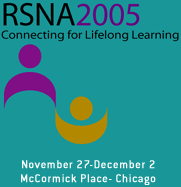
Abstract Archives of the RSNA, 2005
SSQ08-06
Changes in Dynamic Contrast-enhanced CT (dceCT) Parameters in Patients with Carcinoid Liver Metastases Undergoing anti-VEGF versus Interferon Therapy
Scientific Papers
Presented on December 1, 2005
Presented as part of SSQ08: Gastrointestinal (Liver: Focal LesionsóCT)
Chaan Soong Ng MD, Presenter: Nothing to Disclose
Silvana Castro Faria MD, Abstract Co-Author: Nothing to Disclose
James Yao, Abstract Co-Author: Nothing to Disclose
Xuemei Wang, Abstract Co-Author: Nothing to Disclose
Chusilp Charnsangavej MD, Abstract Co-Author: Nothing to Disclose
To assess differences in dynamic contrast enhanced (dceCT) perfusion parameters in patients with metastatic liver disease from carcinoid undergoing targeted anti-VEGF therapy (Bevacizumab, BEV), versus pegylated interferon (PEGI).
DceCT was undertaken in a prospective randomized Phase II Clinical trial of BEV versus PEGI in patients with carcinoid liver metastases. Scans were performed at baseline, at 48 hours, and 18 weeks after initiation of therapy with BEV (Avastin), and at 9 weeks and 18 weeks with PEGI. Cine CT data was acquired utilizing a multislice scanner (4 x 0.5 cm axial slab, 1 second rotation, single 30 second breath-hold), and intravenous injection of non-ionic contrast medium (40 ml, 7 ml/sec). Tumor regions of interest were evaluated for tumor blood flow (TBF), blood volume (TBV), and permeability surface area product (PS) utilizing commercially available CT perfusion software (version 3, GE Medical Systems). A total of 37 evaluable lesions in 25 patients formed the basis of this study. Changes in perfusion parameters between time points and between therapies were compared utilizing the Wilcoxon sign-rank and rank-sum tests, respectively.
TBF and TBV fell significantly after 48 hours and 18 weeks of therapy with BEV compared to baseline (percent change (range)): -48% (-73%, -21%) [p=0.0006], -40% (-63%, -20%) [p=0.0009], and -39% (-68%, 8%) [p=0.01], -34% (-75%, -40%) [p=0.04], respectively. TBF and TBV also fell after 9 and 18 weeks of PEGI, but not significantly. PS was lower at all time points for both therapies, but not significantly, except for BEV at 48 hours [p=0.02]. All three perfusion parameters were significantly lower at 18 weeks with BEV compared to PEGI [p=0.05, p=0.05, p=0.02, respectively].
This preliminary data suggests that the anti-VEGF agent Bevacizumab mediates a more potent effect on tumor perfusion in carcinoid liver metastases than PEGI; furthermore, dceCT is able to detect such changes as early as 48 hours after commencement of therapy. This suggests that dceCT may be a valuable non-invasive technique for assessing the early efficacy of anti-angiogenic therapies in tumors.
Ng, C,
Faria, S,
Yao, J,
Wang, X,
Charnsangavej, C,
Changes in Dynamic Contrast-enhanced CT (dceCT) Parameters in Patients with Carcinoid Liver Metastases Undergoing anti-VEGF versus Interferon Therapy. Radiological Society of North America 2005 Scientific Assembly and Annual Meeting, November 27 - December 2, 2005 ,Chicago IL.
http://archive.rsna.org/2005/4406584.html

